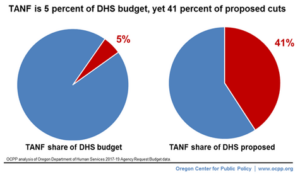Some of Oregon’s poorest families with children are slated to be among the first victims of state budget cuts, should those cuts come to pass. With Oregon facing a $1.41 billion shortfall for the upcoming budget period, the Oregon Department of Human Services (DHS) has drawn up a list of proposed cuts.[1] Near the top of that list is a recommendation to shorten the time a parent can get help from the Temporary Assistance for Needy Families (TANF) program — a proposal that would inflict further suffering on Oregon’s poorest families with children.[1]
The Governor and legislature should reject any approach that would balance the budget on the backs of Oregon’s most vulnerable children.
TANF is a lifeline for Oregon’s poorest children
TANF is Oregon’s principal safety net program for children in poverty. It helps families that have fallen on hard times — including women and children escaping abuse — avoid homelessness and get back on their feet. TANF provides modest cash assistance and services, such as subsidized child care, job training, and employment supports. Oregon currently serves about 24,000 families, including nearly 42,000 children.[3]
Only very poor families that have exhausted personal resources can get help from TANF, and the cash assistance they receive is meager. For instance, the maximum grant amount for a parent with two children is $506 per month — just 31 percent of the federal poverty level.[4]
To stay in the program, parents must participate in the Job Opportunity and Basic Skills (JOBS) program, where they must carry out a plan to address employment barriers and secure a job. While short-term training is allowed, higher education cannot be included in the plan. Only those experiencing a substantial barrier to work, such as a disability, are not subject to this requirement. If at any time a parent fails to carry out the case plan, the family faces sanctions — reductions in the cash grant they would otherwise receive. Continued failure to adhere to the plan results in an end to all cash assistance.
The TANF program currently limits participation to five years in a parent’s lifetime — an arbitrary limit that does not account for the range of challenges faced by very poor families with children. For context, parenting for two children generally lasts at least 20 years. After five years of lifetime participation, the parent is dropped from the cash grant. The household may continue to receive a reduced amount for the children, as long as the parent complies with the case plan.[5] The program recognizes a few exceptions to the five-year limit.[6]
Poverty harms a child’s development
Reducing the resources for a household already under economic strain can harm children. Research shows that poverty impairs a child’s development, particularly in the early years. The stress caused by poverty during childhood can impact a child’s cognitive development, their physical health, and his or her economic future as an adult.[7]
TANF families would bear the brunt of budget cuts
Under the budget-cutting scenario DHS has outlined, TANF would pay a heavy price. TANF makes up about 5 percent of the DHS budget, yet the proposed cuts to TANF amount to about 41 percent of all of the cuts proposed by the agency.[8]

The list of 57 cuts proposed contain several to reduce the time that families can get help from TANF.[9] The cuts are listed in priority order and include:
Reducing the TANF lifetime limit from five to four years. This cut, which DHS placed as its second highest priority, would eliminate a parent’s eligibility for cash assistance after four years. While the cut technically applies only to the parent, the fact that families are a single economic unit means that the entire family — children included — would sink deeper into poverty. This proposal would affect nearly 4,000 families per month over the next biennium — approximately one of every six households receiving help.[10] The policy would save the state General Fund $7.9 million over next biennium.[11]
Imposing a four-year lifetime limit on adults and children with no exceptions. Another option proposed by the agency is to cut cash assistance for both the adults and the children in households after four years, completely eliminating grants to these families. The agency would no longer allow exceptions. This action would save the state an additional $14.8 million.[12]
Imposing a three-year lifetime limit on adults and children with no exceptions. To cut even deeper, the agency proposes to reduce the limit to three years and apply it to both adults and children without exceptions. The change would save the state an additional $41,6 million.[13]
Time limit reductions affect parents with the greatest barriers
The proposed cuts would harm the most vulnerable families in the TANF program, a program that already helps only the poorest in our state. Some families rely on TANF for a brief period; in good economic times a healthy parent with marketable skills, reliable transportation, and reliable child care may find employment quickly and never again need assistance. For other families, these components may not all be in place continuously. For instance, a parent with a child with special needs may have difficulty securing appropriate child care and therefore have trouble holding down a job. Or a parent may have a chronic health condition that periodically hampers their ability to maintain work.
Disability is, in fact, a common reality among Oregon TANF families. Sixty percent of TANF families include a person with a disability.[14]
Parents approaching the five-year limit are more likely to have significant barriers to employment compared to those who leave the program earlier. A study in Washington State showed that 64 percent of parents affected by new restrictive time limit rules had a mental health condition and 25 percent had a substance use disorder. And while 23 percent had a chronic illness, few of those individuals were able to access SSI disability payments within three years of the end of cash assistance.[15] Other studies mirror these findings and also show that households at the time limit are more likely to have parents with lower education levels, have an adult or child with persistent health problems, and be affected by domestic violence.[16]
Thus, various DHS proposals to reduce the TANF time limit — cutting resources to cash-strapped families — would disproportionately impact the most vulnerable of the vulnerable. The actions would likely result in increased family instability, homelessness and poorer outcomes for children.[17]
Policymakers should reject cuts that would harm Oregon’s poorest children
TANF plays an important role in preventing homelessness and fostering economic stability among families that have fallen on hard times. The cuts to TANF proposed by DHS would harm the most vulnerable families with children within a program that already serves only very poor families. To avoid undermining children’s current and future wellbeing, the Governor and lawmakers should reject proposals to balance the state budget on the backs of Oregon’s poorest families.
[1] OCPP analysis of data from the Legislative Fiscal Office and Legislative Revenue Office. 2017-19 General Fund/Lottery Funds Tentative Budget, Oregon Legislative Fiscal Office and Oregon Department of Administrative Services, August 10, 2016, and LRO Forecast Summary, Legislative Revenue Office, September 2016, p. 5.
[2] Department of Human Services 2017-19 10% CSL Reductions List, Oregon Department of Human Services.
[3] As of April 2016, Oregon’s TANF and Pre-SSI/SSDI (TANF for parents applying for federal disability benefits) programs served 23,641 families including 41,894 children. Department of Human Services 2017-19 Agency Request Budget, p. 613.
[4] OCPP analysis using an estimated 2016 Federal Poverty Threshold using the Congressional Budget Office’s January 2016 projection of inflation.
[5] The cash grant amount for a household with two children where no adults are eligible is $348 per month.
[6] Examples include participating in the short-term subsidized jobs program JOBS Plus, experiencing domestic violence, and caring for a child with a disability. Under these and a few other circumstances, most of which are temporary, a family may receive cash assistance after five years if the adult continues to carry out their case plan. Temporary Assistance to Needy Families Reinvestment: Final Recommendations: Benefits Cliff, Re-engagement, Time Limits, Community Collective Impact, Department of Human Services, February 2, 2016, pp. 10 – 13.
[7] Best Practices to Breakthrough Impacts: A Science-Based Approach to Building a More Promising Future for Young Children and Families, Center on the Developing Child, Harvard University, May 2016. Also, Duncan, Greg J, and Katherine Magnuson, “The Long Reach of Early Childhood Poverty”, Pathways, Winter 2011, available at:.
[8] Calculation of TANF budget cuts do not include proposals to cut the Employment Related Day Care program, another Self-Sufficiency program. Department of Human Services 2017-19 10% CSL Reductions List, Oregon Department of Human Services.
[9] Ibid.
[10] The action would affect 3,952 families over the 2017-19 biennium. Ibid, priority #2.
[11] Ibid, priority #2.
[12] Ibid., priority #30.
[13] Ibid., priority #39.
[14] Department of Human Services 2017-19 Agency Request Budget, Oregon Department of Human Services, p. 610.
[15] Patton, Deleena, MelissaFord Shah, Barbara E.M. Felver, TANF Caseload Decline: The Well-Being of Parents and Children Leaving WorkFirst in Washington State, Washington State Department of Social and Health Services, April 2015.
[16] Ovwigho, Pamela C., Kathryn Patterson and Catherine Born, The TANF Time Limit: Barriers and Outcomes among Families Reaching the Limit, Family Welfare Research and Training Group, November 2007. Also, Seefeldt, Kristin S and Gerald R. Ford, Watching the Clock Tick: Factors Associated with TANF Accumulation, National Poverty Center, Working Paper Series #04-9, Revised May 2005.
[17] Notes on priority #30, Department of Human Services 2017-19 10% CSL Reductions List, Oregon Department of Human Services.








